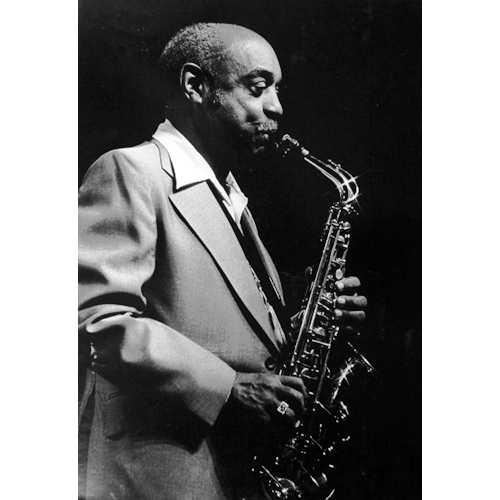
Then in 1958, Carter decided to end his self-imposed leadership prohibition by writing, arranging and recording an LP with a handpicked studio big band. By then, high fidelity and stereo had emerged and albums by Nelson Riddle and Billy May at Capitol were sparking a big-band revival. The expanding popularity of television, with its singer-hosted shows, also was fostering fresh interest in a new band sound. Carter's contribution in this category was Aspects (United Artists), a spectacular example of a seasoned pro fusing high-energy swing with the modern studio sound.
The musicians Carter brought together for the album's two recording sessions consisted of Hollywood's finest. From the outset, there was no intention of having the band tour, allowing Carter to bring in the West Coast's leading studio players. What's more, Carter plays and solos in the band he arranged and led, a change of pace for the then studio writer and player. [Photo of Benny Carter by Doc Ed Lawless]
So who was in this dream band?
The orchestra on the first session in September 1958 consisted of Conrad Gozzo, Shorty Sherock, Pete Candoli and Uan Rasey [pictured] (trumpets); Tommy Pederson, George Roberts and Herbie Harper (trombones) Benny Carter (alto sax and trumpet); Buddy Collette, Bill Green, Justin Gordon and Chuck Gentry (saxes); Larry Bunker (vibes and bongo); Arnold Ross (piano); Bobby Gibbons (guitar); Joe Comfort (bass); and Shelly Manne (drums).
The band on the second September date featured Al Porcino, Stu Williamson, Ray Triscari and Joe Gordon (trumpets); Frank Rosolino, Tommy Pederson and Russell Brown (trombones); Benny Carter (alto sax and trumpet); Buddy Collette, Bill Green, Jewell Grant and Plas Johnson (saxes); Gerald Wiggins (piano); Barney Kessel (guitar); Joe Comfort (bass), and Shelly Manne (drums).
The concept for Aspects, likely conceived by Carter himself since he is listed as the album's producer, was to arrange 12 tunes, each based on a different month of the year. Each of these calendar tributes swings off the wall. Much of the track list consists of month-named standards (June in January, I'll Remember April, etc.). But there are four wonderful originals by Carter (March Wind, August Moon, Something for October and Swingin' in November) and one by pianist-arranger Hal Schaefer (February Fiesta).
Given its top-of-the-year theme, Aspects is perfect listening for January. Individual solos are sterling throughout, and Carter's reed work, particularly on March Wind, soars. Carter's writing is uptempo and tight, with his signature sound on display: reeds laying down a line, muted trumpets chattering on top like shivering teeth before trombones enter for a bouncy burst and the entire band plunges in for a chorus. There are powerhouse swingers like I'll Remember April and June Is Busting Out All Over (dig the unbelievable reed writing!). There also are several cute pieces, like One Morning in May, which Carter arranged with a Shearing-quintet flavor.
For me, there are two musical ingredients that make this album particularly exciting. In addition to Carter's rising alto sound, the trumpet sections pack quite a punch. Knowledgeable fans of the period will recognize the top-flying horns. The other standout flavor is Shelly Manne [pictured], whose drums never stop surging, swishing and hustling. Best of all, he's beautifully miked, so you hear every nuance.
Some have criticized Aspects for being too gimmicky given its tune-of-the-month club theme. Hogwash, I say. Carter's writing is sensational, and there isn't a commercial note played on the entire recording. And the more you listen to Aspects, the more you realize how deceptively tough these charts were to play brilliantly with minimum rehearsals. Hence, the need for a Murderer's Row of studio musicians.
After Aspects, Carter would be back to more pop fare (Benny Carter Plays Cole Porter's Can-Can & Anything Goes,) and playing in The Five Pennies film orchestra. But in September 1958, Carter once again flexed his leadership muscles, recording a swinging masterpiece.
JazzWax tracks: Aspects on CD (Blue Note) is out of print. But copies are being sold by independent sellers for as little as $6.50 here. The album also may be available from music download sites.
This story appears courtesy of JazzWax by Marc Myers.
Copyright © 2024. All rights reserved.


























